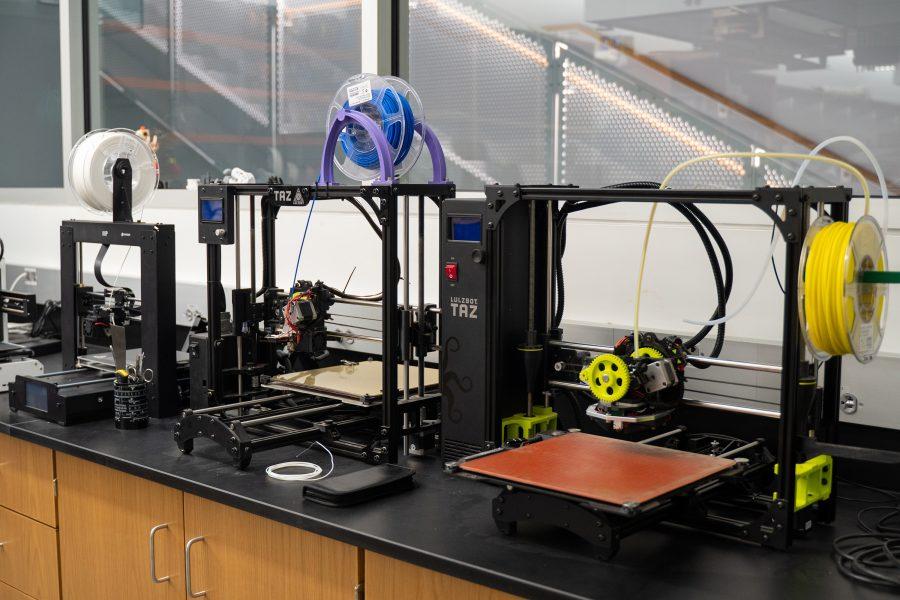Have a hole in a favorite shirt and no sewing kit to repair it? A sculpture idea you’d love to make but don’t have the materials for? A household appliance that would work so much better if you could tweak it just a little? A project you want to build for a class, but aren’t sure where to start?
Carleton’s Class of 1969 Makerspace is here to help.
Located in the basement of the Evelyn Anderson Science Hall, the room is filled with a range of resources including materials for 3-D printing, laser cutting, sewing, screen printing, electrical work and more—all free for student use, though the quantity of materials used per student per term will be capped around $30-$40, according to project leader Aaron Heidgerken-Greene. The exact dollar limit is still uncertain, he clarified, and will depend on the number of students using these materials. Students with project ideas should submit the proposal form available at the Makerspace website (carleton.edu/makerspace), but Heidgerken-Greene is quick to explain that the proposal is not a selective application process but “a way of keeping track of who’s using the space, and for what.”

The Makerspace has only been open for two weeks, according to Heidgerken-Greene, but it’s already been put to a wide variety of use: students have come in to make rubber stamps for their business, to tailor a shirt, to print a chess set, and even in one case to build a microphone.
For Sebastian Kimberk ’20, the Makerspace offered the resources to solve a practical problem: the motion-sensitive paper towel dispenser in his house is located directly above the sink, so that “whenever you do the dishes, it goes off and you end up with a bunch of wet paper towel mixed in.” With Heidgerken-Greene’s help and access to a button and wire from the makerspace, Kimberk successfully soldered on a non-invasive extension to an internal button, so that the motion detector can be covered with a sticker and towels can be dispensed by pressing the button.
“It’s very empowering,” Kimberk says of his experience with the Makerspace, “just to see that you can go from having a bunch of raw materials to having something that actually works.”
That’s an experience that Heidgerken-Greene says he wants to “make an informal part of the curriculum here,” and “not just for people who normally think of themselves as hands-on.” Coming from a decade of work building exhibits for the Science Museum of Minnesota, Heidgerken-Greene says he “really has a love of hands-on learning. I think there is a strong value in just knowing how the physical world works, being able to come in and know how to repair your own clothes or make something entirely from scratch.”
In an effort to open the Makerspace up to a diverse population of students, Heidgerken-Greene will be hosting an open house October 26, where students can check out the space, talk to people involved, and even complete small projects. “We’ll have electronics kits so you can build a blinking light for your backpack for when you’re biking, and then we’ll also have some capacity for building foxtails,” he reports, “So I’d encourage people to stop by!”
Bringing a diverse array of people into the Makerspace has been a goal of Heidgerken-Greene’s from the beginning. “When hiring student managers,” he offers as an example, “we tried to reach out as broadly across campus as possible so that we could have them be pulling new people into the space as well; we have people from costume design shops, we have people with backgrounds in Boliou art studio.” The goal, ultimately, is for the Makerspace to be a kind of “one-stop shop” for students’ hands-on building needs—whatever those may be.
To Kimberk, that’s an incredibly exciting prospect to have on campus: the first time he went there, he recalls thinking, “Oh my God, it’s incredible this exists!”
For that, Carleton has the Class of 1969 to thank; as a plaque on the makerspace wall proclaims, this class “dedicated a portion of their gift to the makerspace [to affirm] the importance of creativity, collaboration, and entrepreneurship to a liberal arts education,” in hopes that “students across disciplines will use this space to bring ideas to fruition in bold and exciting ways for generations to come.”













